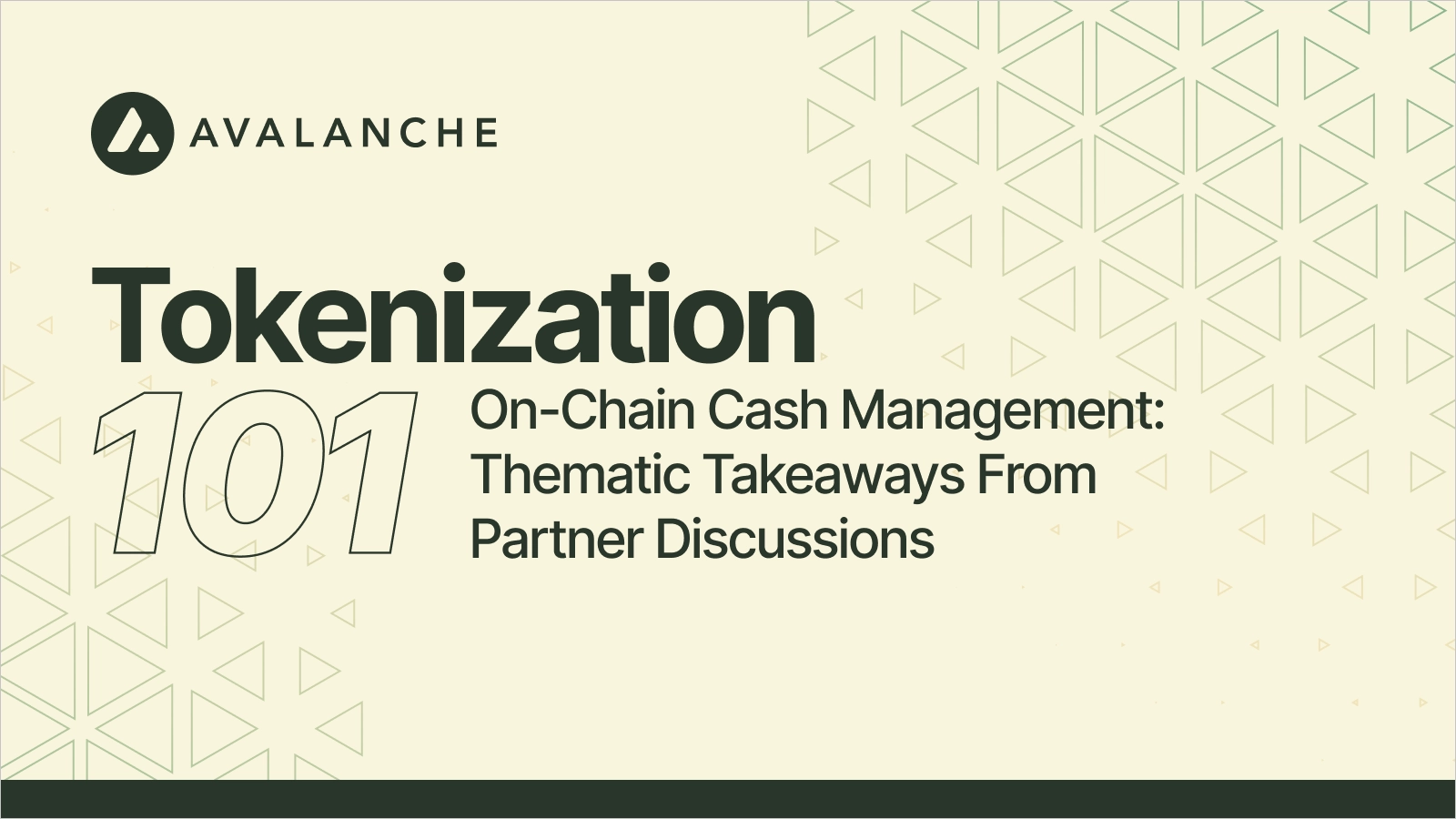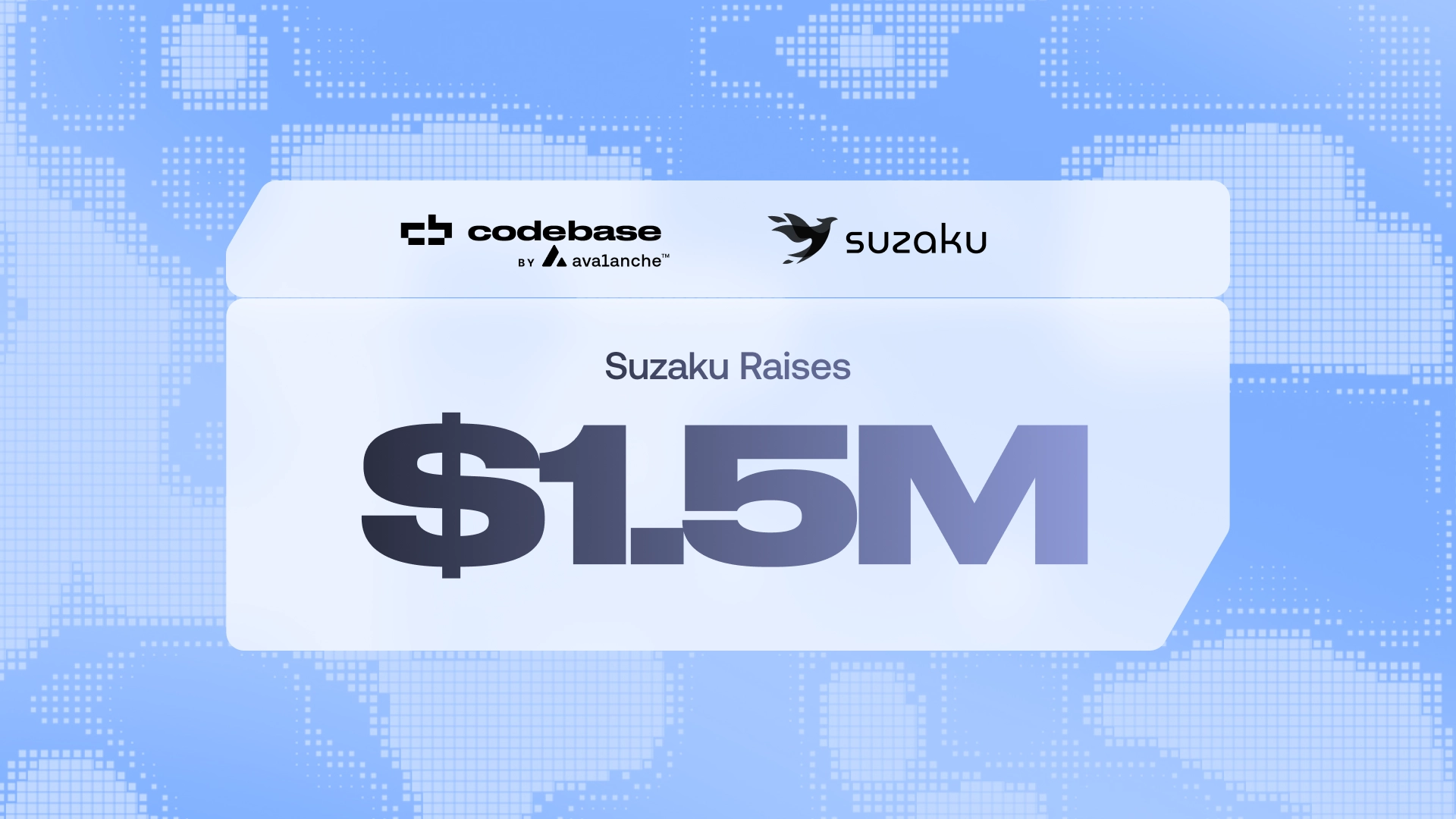On-Chain Cash Management: Thematic Takeaways From Partner Discussions
On-Chain Cash Management: Thematic Takeaways From Partner Discussions
Aug 30, 2023 / By Avalanche / 7 Minute Read

Key learnings from 100+ Avalanche ecosystem partners about cash management, treasuries, stablecoin balances, and on-chain yields.
Overview
Recently, teams from both the crypto native and traditional financial services sides of the spectrum have launched tokenized US money market funds, T-bills, or comparable short duration products; some notable examples include offerings from OpenTrade, Ondo, Superstate, Matrixport, Franklin Templeton, OpenEden, etc. As a BD team, we’ve met with 20+ of these teams in the context of their deployment strategies and our mandate to drive the growth and adoption of Avalanche. Oftentimes, their go-to-market (GTM) strategies tend to focus on attracting on-chain capital; in support, they point to the large circulating supply of non-yield bearing stablecoins and the attractiveness of a non-crypto correlated, yield-bearing asset for better cash management and diversification.
To verify and more comprehensively inform this thought process, we recently surveyed partners from across our ecosystem to learn how they think about their treasuries, stablecoin balances, and on-chain yields in the context of cash management and diversification. After receiving feedback from nearly 100 protocols, DAOs, hedge funds, venture capital (VC) funds, and other personas, we wanted to share thematic takeaways to help guide teams tokenizing assets in their business development and GTM strategies, and to help respondents get a sense of how their peers approach cash management.
Primarily, we wanted to more fully understand:
Where respondents held funds (on- or off- chain);
If and how they thought about yield on cash/stablecoins;
Whether they wanted to access US Treasury (UST) products on-chain;
If they were open to KYC processes; and
Whether and how better access to on-chain UST yields would alter their approach.
While some takeaways were more surprising than others, it’s clear that we’re still early in many ways and the debate around on-chain cash management is far from settled. Thank you to our partners who participated. We welcome your continued feedback, which has been invaluable in informing our approach to helping grow the Avalanche ecosystem.
General Themes
Risk-Adjusted Yields Matter
Of those interested in UST yields, most are generally indifferent about accessing them on-chain vs. off-chain. The key consideration, rather, is identifying the better risk-adjusted yield. To that end, all else being equal, an on-chain T-Bill yield is perceived as an “inferior” risk-adjusted return compared to the traditional off-chain equivalent. For the smaller subset whose stables are “trapped” on-chain; however, it can be painful not having ready access to UST yields, particularly when DeFi yields have become so depressed.
Size Matters
Whether it’s a fund’s AUM or the size of a protocol’s treasury, the larger and more established a persona is, the less likely it is to consider accessing UST yields on-chain. Regardless of their mandate, large funds (especially in the US) have no problem accessing financial products through traditional means. For DAOs with large treasuries, balances have generally been held in a native token, which may not have been diversified during more favorable market conditions as a result of cumbersome governance processes, poor optics / community pressure, or inopportune timing. As DAOs become more proactive and sophisticated at treasury management, the next bull market may prompt them to more strongly consider converting part of their treasuries into stables–enabling them to diversify their risk exposure and extend their runways.
Location Matters
Between US and non-US respondents, there is a stark split in attitudes toward tokenized UST products. Respondents in Asia in particular are eager to access UST yields on-chain, largely because they might not have easy access otherwise.
Battle-Tested Smart Contracts Matter
Generally, large on-chain players do not want to deploy large sums into untested code bases, and certainly not into unaudited code bases. However, most are rather comfortable putting excess cash into battle-tested DeFi codebases like Aave, which have processed billions of dollars worth of TVL.
Ease of KYC’ing Matters
Generally, institutional personas who are active on-chain do not mind KYC processes, but nearly all are strongly against excessively cumbersome onboarding processes. And for the more crypto-natives like DAOs or some protocol treasuries, KYC processes can become exceedingly difficult, even if there is initial openness to them. This point of friction has generally caused respondents to shy away from KYC’d dApps / permissioned DeFi.
T-Bills vs. Everything Else: Product Matters
For the respondents interested in accessing traditional, or off-chain asset (OCA) yields on-chain, there is no real motivation to touch anything beyond short-term UST yields at this point. People like the liquidity from yield-bearing, short-duration instruments like money market funds. This asset is easier to understand, while credit, duration, and market risks may not need to be considered.
Themes by Persona
Protocol & DAO Treasuries
Most are still establishing robust treasury management processes and generally skew very conservative. Funds are kept mostly on-chain in multisigs, rarely generating yield. Those that think about deploying capital focus mostly on allocating liquidity to support their business or ecosystem objectives. Most are just starting to wake up to tokenized OCAs. DAOs might be suited to diversify into on-chain yield opportunities, as both they and the market evolve. However, governance and onboarding hurdles must be addressed.
Liquid Token Funds
Liquid token funds tend to be more crypto-native and very comfortable with battle-tested dApps / code bases. They are generally indifferent to KYC’ing. While they would consider allocating cash to tokenized UST yields–especially if they can utilize those allocations in the DeFi ecosystem–most are happy playing wait-and-see for now.
Quant Funds
Quant funds tend to be more natural buyers of products like tokenized T-bills. Most keep a portion of funds in stables when not actively in crypto positions, which is fairly frequent nowadays given the sideways price action in recent months. Quant funds would be very receptive to a traditional yield-bearing option while sitting in stables, but at the moment generally do not have a strong enough option they are particularly comfortable with.
DeFi Funds
DeFi funds are very focused on yield-generating strategies given their mandate, so USTs may not clear their yield hurdles but are intriguing. Overall, they’re more interested in the interoperability/composability of future product iterations and middleware-enabling looping strategies (i.e., levered returns on-chain). Generally DeFi protocols want to see more traction before building tokenized T-Bills into existing products, though we are starting to see more protocols wanting to accommodate these new on-chain instruments.
Digital Asset Managers
This persona typically has strong TradFi roots, favors KYC, and tends to prefer fiat over stablecoins. They may be open to DeFi activity but generally tend to use CeFi desks / digital asset prime brokerages for on-ramping crypto, executing trades, custody, and so forth. CeFi desks typically provide rewards for holding stables, but an adequate tokenized T-Bill offering could help transition some of these funds on-chain.
VC Funds
While the lines between VC and liquid token funds are often blurred in crypto, VCs generally don’t optimize for shorter-term yield generation for many reasons, including tax-related reasons, different mandate/strategy, and a lack of excess cash while calling capital for investments.
Crypto VCs who do hold tokens are more likely to use tokenized treasuries as a cash management tool. They typically view on-chain yield generation from a strategic lens, e.g., not to make money but to help secure a network or bootstrap liquidity to help portfolio companies get products off the ground. Quite often they will hold cash in majors in order to keep market beta closer to 1 vs. BTC or other L1 tokens, which are often looked at pseudo benchmarks.
Crypto VCs who do not hold tokens are not going to be the first users, but this could be something that makes them consider tokens more seriously.
Family Offices
Family offices are generally far from deploying capital on-chain. There are a few unique single family offices (SFOs) that may be more progressive, have a yield bucket, and/or have a venture bucket that looks at crypto. This small subset is often based in Asia or on the US West Coast and rooted in tech-generated wealth. While these SFOs may find tokenized USTs interesting, nearly all are still a long way away from actively considering on-chain investment opportunities.
Disclaimer: The content contained in this post does not constitute financial or investment advice whatsoever and is for informational purposes only. All examples mentioned here that would otherwise lead anyone to speculate on future deals are completely hypothetical to simply make a point. All observations are general and thematic in nature and do not reflect the opinion of any one specific person or entity.




